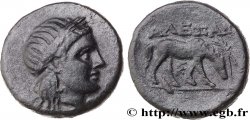v53_0022 - SICILY - SYRACUSE Tétradrachme
MONNAIES 53 (2012)
Starting price : 680.00 €
Estimate : 1 200.00 €
unsold lot
Starting price : 680.00 €
Estimate : 1 200.00 €
unsold lot
Type : Tétradrachme
Date: c. 480/478 - 475 AC.
Mint name / Town : Sicile, Syracuse
Metal : silver
Diameter : 24 mm
Orientation dies : 11 h.
Weight : 17,21 g.
Rarity : R2
Emission: groupe 3, série 8b
Coments on the condition:
Exemplaire sur un petit flan épais, bien centré des deux côtés à l’usure régulière, parfaitement lisible et identifiable. Joli droit. Belle tête d’Aréthuse au revers. Patine grise de collection ancienne
Catalogue references :
Obverse
Obverse legend : ANÉPIGRAPHE.
Obverse description : Bige au pas à droite, conduit par un aurige tenant les rênes et le kentron ; le bige est couronné par Niké volant à droite ; grènetis circulaire perlé.
Reverse
Reverse legend : K RÉTROGRADE.
Reverse description : Tête d'Aréthuse à droite, les cheveux relevés et retenus par un diadème de perles, entourée de quatre dauphins.
Reverse legend : SURAK-O-SIO-N
Reverse translation : (de Syracuse).
Commentary
Mêmes coins que l’exemplaire de l’American Numismatic Society (ANS. 37, pl. I) provenant du trésor de Sélinonte (IGCH. 2084). Au total, nous avons seulement trois exemplaires recensés et aucun ne provient du trésor de Randazzo. Trace de cassure de coin ancienne au droit au niveau de la jambe du cheval qui vient mordre le sol. Légende rétrograde au revers.








 Report a mistake
Report a mistake Print the page
Print the page Share my selection
Share my selection Ask a question
Ask a question Consign / sell
Consign / sell
 Full data
Full data















